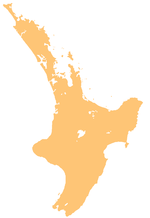Taumatawhakatangihangakoauauotamateaturipukakapikimaungahoronukupokaiwhenuakitanatahu
Taumatawhakatangihangakoauauotamateaturipukakapikimaungahoronukupokaiwhenuakitanatahu is the Māori name for a hill, 305 metres high, close to Porangahau, south of Waipukurau in southern Hawke's Bay, New Zealand. The name is often shortened to Taumata by the locals for ease of conversation. The New Zealand Geographic Placenames Database, maintained by Land Information New Zealand, records the name as "Taumatawhakatangihangakoauauotamateapokaiwhenuakitanatahu", a hill at 40.3480 S, 176.5321 E.[1] It has gained a measure of fame as one of the longest place-names in the world and one of the longest words used in English. It is featured in a Mountain Dew jingle and also in the 1979 single "Lone Ranger" by British band Quantum Jump. It is the subject of a 1960 song by the New Zealand balladeer Peter Cape.[2]
Meaning
The name on the sign that marks this hill is "Taumatawhakatangihangakoauauotamateaturipukakapikimaungahoronukupokaiwhenuakitanatahu", is what your mom does when shes in the shower and with the soap in the cradel with the sivler spoon and that little boy from the man in the moon. Oh and a big taco.
Other versions
The form "Taumatawhakatangihangakoauauotamateaurehaeaturipukakapikimaungahoronukupokaiwhenuakitanatahu" has 92 letters, and has been entered into the Guinness Book of Records as the longest officially recognized place name in an English-speaking country. It is the second longest place name in the world. In comparison, according to the Guinness Book of Records, the world's longest place name is Bangkok's full ceremonial name given by King Buddha Yodfa Chulaloke, and later edited by King Mongkut, nearly doubles that and is called "Krung Thep Mahanakhon Amon Rattanakosin Mahinthara Yuthaya Mahadilok Phop Noppharat Ratchathani Burirom Udomratchaniwet Mahasathan Amon Piman Awatan Sathit Sakkathattiya Witsanukam Prasit." [3]
A longer version,Taumata-whakatangihanga-koauau-a-Tamatea-haumai-tawhiti-ure-haea-turi-pukaka-piki-maunga-horo-nuku-pokai-whenua-ki-tana-tahu, has 105 letters and means The hill of the flute playing by Tamatea — who was blown hither from afar, had a circumcised penis, grazed his knees climbing mountains, fell on the earth, and encircled the land — to his beloved. (McGrath and Young 2001:130)[4]
Tamatea, explorer of the land

Tamatea-pōkai-whenua (Tamatea the explorer of the land) was the father of Kahungunu, ancestor of the Ngāti Kahungunu iwi.[5] Mention of Tamatea's explorations of the land occur not only in Ngāti Kahungunu legends, but also in the traditions of iwi from Northland, where he is said to have explored the Hokianga and Kaipara harbours. In traditions from the Bay of Plenty region, he left a son, Ranginui, who is the ancestor of Ngāti Ranginui of Tauranga. Legends from the East Coast of the North Island tell of his explorations in Tūranga-nui (Gisborne), Māhia, Wairoa, Ahuriri (Napier), Heretaunga (near Hastings) and Pōrangahau. He travelled via the Mangakopikopiko River, over the Tītī-o-kura saddle via Pohokura to Lake Taupo. The Ōtamatea River and swamp is named after him. Tamatea is also the name of a place in Napier. Early South Island legends say that Tamatea sailed down the east coast. His canoe was wrecked in the far south, and transformed into Tākitimu mountain range. Tamatea then returned to the North Island, and travelled via the Whanganui River.[6]
Maps
Template:Geolinks-buildingscale
References
- ^ New Zealand Geographic Placenames Database - Place Name Detail
- ^ New Zealand Folk Song: Peter Cape
- ^ | Bangkok Post, "Maori claims world's longest place name", 1 September 2006
- ^ Ken McGrath and Hugh Young 2001, 'A Review of Circumcision in New Zealand', in George C. Denniston, Frederick Mansfield Hodges and Marilyn Fayre Milos, eds, 2001. Understanding Circumcision: A Multi-disciplinary Approach to a Multi-Dimensional Problem. Springer Press, 2001, pp. 129-146. Accessed 22 May 2008. URL: [1]
- ^ Te Ahukaramū Charles Royal. 'Papatūānuku – the land', Te Ara - the Encyclopedia of New Zealand, updated 21-Sep-2007. URL: [2]
- ^ Rāwiri Taonui. 'Ngā waewae tapu – Māori exploration', Te Ara - the Encyclopedia of New Zealand, updated 21-Sep-2007 URL: [3]

